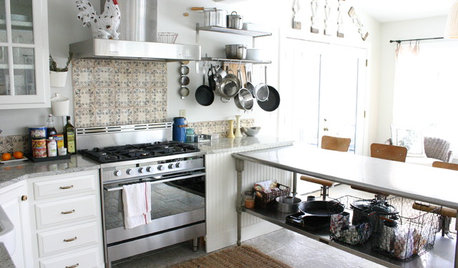Back to the worms!!
wildgoat
14 years ago
Related Stories

GARDENING GUIDESHouzz TV: Make a Worm Bin for Rich Soil and Happy Plants
A worm-powered compost bin that can fit under a sink turns food scraps into a powerful amendment for your garden. Here’s how to make one
Full Story
HOUZZ TOURSMy Houzz: Metropolitan Chic in Boston's Tony Back Bay
A 1928 penthouse apartment with river views gets elegant updates that nod to the past
Full Story
GARDENING GUIDES7 Ecofriendly Gardening Ideas That Also Cut Chore Time
Spend less time weeding, less money watering and more moments just sitting back and enjoying your healthy garden
Full Story
MOST POPULARThe Perfect Houseplant for People Who Kill Houseplants
If you can fill a jar with water, you can keep golden pothos vine happy — and it will pay you back with cleaner air and a greener home
Full Story
KITCHEN CABINETSWorld of Design: The Appeal of the German Kitchen
German kitchen brands are household names across Europe, with roots reaching back more than a century
Full Story
DECORATING GUIDESSummer Style: 20 Fresh Ways to Bring in the Season
From surfboards and seashells to mason jars and hammocks, keep that laid-back vibe going through summer and beyond
Full Story
GARDENING FOR BIRDSWhat to Know About Birds Nesting in Your Yard
Learn how to observe, record data and help ornithologists with NestWatch’s citizen science project understand bird trends
Full Story
KITCHEN DESIGNCockadoodledoo! Roosters in the Kitchen
Add Country Charm and Good Luck With a Chicken in the Cucina
Full Story
GARDENING GUIDESLush, Foodie Abundance in a Small Urban Garden
This modest backyard garden provides its owner with fruit and vegetables all year round, thanks to an innovative low-maintenance approach
Full StorySponsored
Columbus Area's Luxury Design Build Firm | 17x Best of Houzz Winner!
More Discussions







sbryce_gw
wildgoatOriginal Author
Related Professionals
Arnold Landscape Architects & Landscape Designers · East Rancho Dominguez Landscape Architects & Landscape Designers · Wake Forest Landscape Contractors · Avocado Heights Landscape Contractors · Aberdeen Landscape Contractors · Amesbury Landscape Contractors · Blue Springs Landscape Contractors · Burien Landscape Contractors · Canyon Lake Landscape Contractors · Lynchburg Landscape Contractors · North Lauderdale Landscape Contractors · South Farmingdale Landscape Contractors · Wallingford Landscape Contractors · Claremont General Contractors · Rocky Point General Contractorsplumiebear
sbryce_gw
wildgoatOriginal Author
sbryce_gw
plumiebear
wildgoatOriginal Author
plumiebear
sbryce_gw
marauder01
sbryce_gw
plumiebear
marauder01